
Sohan Qadri
Encyclopedia
Sohan Qadri is a yogi, poet and a painter from India who has lived in Copenhagen
for the past 30 years. His paintings result from states of deep meditation, and are informed by the colors of India: luminous, dye-infused works on meticulously serrated paper. Over his long career, Qadri has interacted with a wide array of cultural figures including Surrealist painter René Magritte
, Nobel laureate Heinrich Böll
, and architect Le Corbusier
. Böll once said, "Sohan Qadri with his painting liberates the word meditation from its fashionable taste and brings it back to its proper origin." He has had more than 70 exhibitions in the United States, Europe, Asia, and Africa.
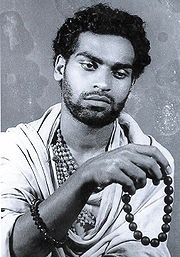
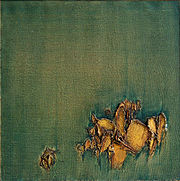
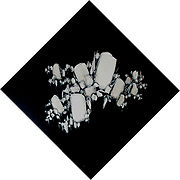

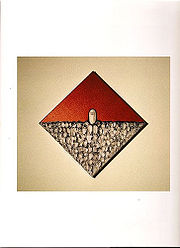 Sohan Qadri was born in the village of Chachoki, in 1932, in British India. Chachoki is near the industrial town of Phagwara in the Kapurthala district
Sohan Qadri was born in the village of Chachoki, in 1932, in British India. Chachoki is near the industrial town of Phagwara in the Kapurthala district
of Punjab. He grew up in a wealthy farming family—his mother was Hindu and his father was Sikh. With no electricity, running water, roads or cars, Chachoki was only a few miles from the more cosmopolitan city of Kapurthala, with its many palaces and official buildings in the French Neo-Classical style, which were built by a Francophile maharajah.
As a boy of about seven, two spiritualists living on the family farm entranced him. The first was Bikham Giri, a Bengali Tantric-Vajrayan yogi. The second was Ahmed Ali Shah Qadri, a Sufi, who lived within walking distance of Giri. Both gurus taught him spiritual ideals through meditation, dance and music. Though neither was a teacher in the traditional sense, nor were they interested in proselytizing, their impact was profound. Qadri’s association with them heralded a lifelong commitment to spirituality and art.
Qadri’s artistic talent was first expressed in the village pond. Before bathing, he would play with lumps of mud, shaping them into various toys using sticks and stones. He gouged, scratched and marked the forms— techniques that still prevail in his work—to define features such as eyes and noses. His visual influences came from village life where nature is pervasive. Qadri grew up encircled by the Kangra hills, lush woodlands, gushing streams and a patchwork of cotton and wheat fields.
Qadri continued his schooling in until the eighth grade when he sat for his matriculation exam. His mother wanted him to take charge of the family farm. Initially, he did not display any distress over this, but the anxiety eventually prompted him to run away to the Himalayas. He made his way to Karnaul and into Tibet, staying in monasteries for several months, living among spiritualists and forest dwellers. Meanwhile, his mother dispatched a cousin, a wrestler, to bring him home. He tried to run away twice more but was compelled to return. Eventually, Qadri stood his ground. His refusal to take over the farm dashed his mother’s hopes of extending the family’s upward mobility. Qadri who was the first village child to have gained matriculation, instead completed his three-year undegraduate degree at Ram Garhia College and pursued his art by apprenticing himself to Pyara Singh, a photographer with a studio in Jullandhar, Punjab.
After Pyara Singh immigrated to England in 1952, Sohan left Jullandhar for Bombay. Modernism was an urban phenomenon, and in order to pursue his interest in art he felt he had to leave village life behind. Qadri settled in Parel and worked as a still photographer in an early Bollywood studio in Andheri, Bombay. Unable to find the artistic fulfillment he was seeking, he resigned after completing only two films. While in Bombay he discovered the renowned JJ School of Art and the work of modernist artists Krishna Ara, K.K. Hebbar and Shanti Dave.
Through Ara, Hebbar and Dave, Sohan learned of the existence of fine art colleges where one could receive specialized training, and in 1955, he enrolled in the Simla College of Art, Simla. Satish Gujral, a noted modern painter, was teaching at the college after having spent time with Diego Rivera, Frida Kahlo and David Alfaro Siqueiros in Mexico. The curriculum was modeled after the Royal College of Art in London and also specialized in the Rajput and Mughal styles of painting.
While a student, Qadri visited the art galleries of Delhi. He met the renowned artists Sailoz Mukherjee and J. Swaminathan, who were in the process of starting the group Unknown. He became immersed in the artistic milieu of the pioneering Indian modernists M.F. Husain, Syed Haider Raza, J. Swaminathan, and Ram Kumar. The postwar period was a productive time for emerging artists like Qadri who faced modernism in full bloom. Their predecessors, including the Calcutta Group
(1942) and the Progressive Artists Group of Bombay (1947), had already defined a vocabulary of modernism based on certain Indian modes of expression and Western modernist syntax. Qadri and his contemporaries were able to build on this vocabulary and even reject their predecessors’ reliance on figuration, which, these earlier artists believed defined them as authentically Indian.
After finishing his degree, Qadri returned home to Phagwara and joined the faculty of the Phagwara Teachers Training College for three years. In 1961, Dr. Mulk Raj Anand
, the founder and editor of the art journal Marg, and associate of the Bloomsbury Group of London, recognised Qadri’s talent. After viewing his work at a faculty exhibition, he singled Qadri out and promised to visit his village. Anand spontaneously supported young talent throughout India, and he became Qadri’s first major patron. Anand arrived in Phagwara in 1963 with Pierre Jeanneret
, an architect and cousin of the architect Le Corbusier, who acquired a painting for his collection.
Anand and Jeanneret invited Qadri to bring his work to the newly built city of Chandigarh, capital of Punjab and Haryana, designed by Le Corbusier. Qadri’s first exhibition was the second exhibition to be held at Gandhi Bhavan, the Punjab University Library art gallery designed by Jeanneret (the first was MF Husain’s). During this time Sohan changed his last name from Singh to Qadri as a sign of devotion to his Sufi teacher.
After gaining critical acclaim, Qadri began to paint seriously, and in the small town of Jullandhar, began to teach himself about the School of Paris. As was often the case with artists living outside European artistic centers, modernism appeared through secondary material – particularly print media. Sohan educated himself by looking at the magazines Studio International, Illustrated Weekly of India, and Modern Review, as well as reading lectures and books. While reading about Francis Newton Souza
, an enfant terrible of Indian art, and his adventures in Paris, Qadri dreamed of visiting modernity’s capital. In the meantime, he built a studio of mud and straw bales in Chachoki and began to teach himself about the Indian and international art scene.
Qadri started creating figurative works, slowly veering toward abstraction, and ultimately abandoning representation in a search for transcendence. “When I start on a canvas,” he says, “first I empty my mind of all images. They dissolve into a primordial space. Only emptiness, I feel, should communicate with the emptiness of the canvas.” Instead of using subject matter drawn from the disaffected, gritty urban world like many of his contemporaries, he searched for subject matter that inspired spiritual feelings and turned to an Eastern mode of expression full of bhava or mood. “I was focusing purely on color and form without distraction from figure,” he says.
Qadri developed the methodology of painting during this period that he still uses today. He divided pure colors into three categories or parts: dark, warm or cool, and light. Dark colors form the earth element or lower level. Warm or cold colors denote energy, each of which possesses a different vibration (vigorous when warm and mild when cold), and form the middle level, and light colors, the upper level. This allowed for a tripartite arrangement that could be organized in descending or ascending order.
In 1962, Qadri had his second exhibition at Sridharani Gallery in New Delhi. After the Sridharani exhibition, and with the help of Randhawa and Dr. Anand in Delhi (then chairman of the Lalit Kala Akademi), several galleries took interest in his work. At the time, Indian artists largely found patrons among the diplomatic or expatriate community, along with a few Indians interested in modern art. Among the collectors of Qadri’s early art were the Belgian Consul and the Canadian and French ambassadors to India.
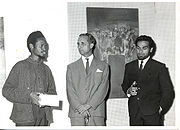
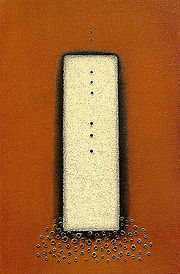 Prompted by Anand, Qadri decided to travel outside of India and devote himself full-time to painting. He had his first international exposure in Africa. Qadri managed to get a fictitious invitation to a wedding in Nairobi, which helped him secure a passport, a difficult feat at the time. When he learned that he could circumvent the three- to six- month wait for permission to leave Nairobi by sailing bunker-class with indigent laborers in the luggage hold of a passenger ship, he and a poet friend immediately booked passage to Mombassa, Kenya. To pass time on the eight-day trip, he sketched his traveling companions, and one day, a passenger from the upper deck. Soon there was a crowd; everyone wanted a portrait done in the realistic style he’d mastered in Simla. For the rest of the journey he traded drawings for food and whisky.
Prompted by Anand, Qadri decided to travel outside of India and devote himself full-time to painting. He had his first international exposure in Africa. Qadri managed to get a fictitious invitation to a wedding in Nairobi, which helped him secure a passport, a difficult feat at the time. When he learned that he could circumvent the three- to six- month wait for permission to leave Nairobi by sailing bunker-class with indigent laborers in the luggage hold of a passenger ship, he and a poet friend immediately booked passage to Mombassa, Kenya. To pass time on the eight-day trip, he sketched his traveling companions, and one day, a passenger from the upper deck. Soon there was a crowd; everyone wanted a portrait done in the realistic style he’d mastered in Simla. For the rest of the journey he traded drawings for food and whisky.
Qadri brought all of his large paintings, which were originally painted in Chachoki for an exhibition at Bombay’s Taj Art Gallery. He hoped to exhibit them in Kenya. When he landed in Mombassa, the port authorities dumped Qadri’s crate of paintings on the pavement because he could not afford a porter. Qadri and his traveling companion sat with the crate for three days and nights until an acquaintance arrived and agreed to drive them the 300 miles to Nairobi.
Once in Nairobi, he contacted Elimo Njau, a Kenyan cultural figure who visited Delhi often. Njau was born in Tanzania and studied fine arts at Makere University College, Uganda. A catalyst of contemporary culture, Njau had established two nonprofit galleries, Paa-yaa-paa in Nairobi and Kibo in Marangu, Tanzania, where both African and international artists exhibited regularly. Njau immediately recognized Qadri’s work, which he had seen in the Kunika Gallery in Delhi. He offered to shuffle another show to squeeze in Qadri’s exhibition. Qadri then went to Prem Bhatia, the Indian ambassador to Kenya, with an introductory letter from Mulk Raj Anand. Bhatia agreed to sponsor the show and use the embassy’s machinery to promote the exhibition. Bhatia bought the first painting for 75 pounds. The show was a sellout and the talk of Nairobi. This exhibition was followed by an equally successful show at the Stanley Gallery in the renovated, American-owned Stanley Hotel.
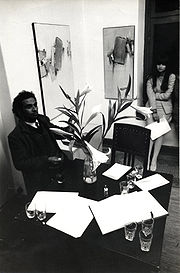
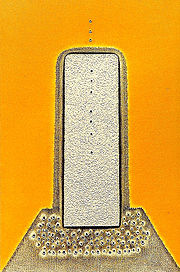
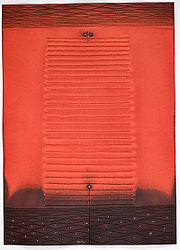 After his stay in Africa, Qadri went to Zurich. A former girlfriend arranged for him to house sit for a friend, an architect named Jorge Plangg. Qadri and Plangg formed a bond, and Plangg gave him the keys to an associate’s colossal villa called Tilgenkamp. At Tilgenkamp, Qadri prepared for his first European exhibition, held in November 1966 at the Gallerie Romain Louis in Brussels. The exhibition was arranged with the help of respected Swiss art critic Mark Kuhn; yet, of the twenty-three paintings exhibited, only one sold.
After his stay in Africa, Qadri went to Zurich. A former girlfriend arranged for him to house sit for a friend, an architect named Jorge Plangg. Qadri and Plangg formed a bond, and Plangg gave him the keys to an associate’s colossal villa called Tilgenkamp. At Tilgenkamp, Qadri prepared for his first European exhibition, held in November 1966 at the Gallerie Romain Louis in Brussels. The exhibition was arranged with the help of respected Swiss art critic Mark Kuhn; yet, of the twenty-three paintings exhibited, only one sold.
Although he had little money, Qadri continued to paint. One day, Kuhn asked Qadri to join him while he interviewed the surrealist painter René Magritte in the artist’s studio. After introductions, Qadri sat quietly while they talked, looking at Magritte’s seminal canvas Ceci n’est pas une pipe sitting on the artist’s easel. After a few hours, Magritte announced that it was his chess time, and that Kuhn should come back the following day to finish the interview. When Qadri told him he’d been a chess champion in Simla, Magritte challenged him to a game, and then quickly beat him.
Before driving with Kuhn from Brussels to Paris to meet Qadri’s first patron, Mulk Raj Anand, and the Indian painter Syed Haider Raza, Qadri sold five paintings to a couple from Montreal who were on their way back to Canada to open a gallery. Once in Paris, he secured an important exhibition in December 1966 at the Gallerie Arnaud alongside major European artists including Pierre Soulages
, George Michaux, Jean Paul Riepal and Louis Fatoux. Seven years later, he would show his works at Arnaud’s sister gallery in Montreal.
When he returned to Zurich, Qadri received an invitation to an international artists’ camp in Kushalin, Poland, where he was given lodging, food and painting materials for two months. The Souks Museum of Modern Art in Kushalin acquired one of the paintings he produced during this period. Next to his studio were two Danish artists, painter Bent Kock, and printmaker Helle Thorborg, who were impressed with Qadri’s work. In 1969, Thorborg arranged for him to visit Copenhagen, through the Danish cultural ministry.
Before going to Copenhagen, Qadri showed his work in Vienna at the gallery Uni Generation and at the Government Printing Press called d’Orchai. He also showed in Munich at Stenzel Gallerie and stayed for a period in 1968 in Paris where he rented American artist Mimi Vaz’s studio in Villa d’Essai. There he mixed with Pierre Soulages and James Michaux, whom he had met at the Arnaud Gallerie, along with the Indian artists Syed Haider Raza, Anjolie Ela Menon, N. Vishwanadhan, and Nikita Narayan. He also met well-known printmaker Krishna Reddy
who was working with his wife, Judy Reddy and the British painter Stanley William Hayter
.
During this time, Qadri stopped painting with impasto oil on canvas and experimented with paper. Though the oils sold well, paper, he felt, was softer, more feminine, and more suited to works that evolved out of a meditative state. “Deep states of being are not brought out by effort,” he says. “When I work with ink and dyes, I don’t have to fight with the canvas. There are no brush strokes, no painter. The aura of the form is the painting.”
While in Paris, the Danish Ministry of Culture offered Qadri a show, including traveling expenses and a stipend. The ministry’s gallery director bought a painting, as did New Yorker Sam Kanner of Court Gallerie. Christian Oberg, from the graphic department of Denmark’s Louisiana Museum, bought several paintings and arranged five exhibitions for Qadri in Denmark.
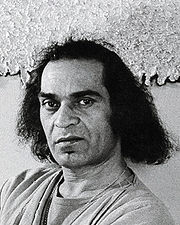
 Copenhagen, tranquil in comparison to larger cities like Paris or New York, proved an ideal place in which to create his serene, meditative art forms. Qadri initially lived with the chairman of the Danish Art Society, Dr. Kaj Borck; however, because he arranged to have several exhibitions at once, he required a studio. Borck’s daughter introduced Qadri to Dr. Fritz Schimitto, an eccentric aristocrat who lived by himself in a large villa. Schimitto was an economist in the Danish Ministry who had worked in the same office, from the same chair, for thirty-five years, calculating Denmark’s per-capita income. He was unusually introverted and had little contact with anyone since the death of his mother two years earlier.
Copenhagen, tranquil in comparison to larger cities like Paris or New York, proved an ideal place in which to create his serene, meditative art forms. Qadri initially lived with the chairman of the Danish Art Society, Dr. Kaj Borck; however, because he arranged to have several exhibitions at once, he required a studio. Borck’s daughter introduced Qadri to Dr. Fritz Schimitto, an eccentric aristocrat who lived by himself in a large villa. Schimitto was an economist in the Danish Ministry who had worked in the same office, from the same chair, for thirty-five years, calculating Denmark’s per-capita income. He was unusually introverted and had little contact with anyone since the death of his mother two years earlier.
The villa, located in the Hellerup area of Copenhagen next to the Indian embassy, was filled with free-flying birds, fish, dogs and turtles. In one of the many dust-covered upper rooms was a giant toy train and in another, Schimitto’s mother’s clothes, laid out just as they were the day she died. Schimitto asked only where Qadri was from, what his profession was and whether he could paint in the villa’s odd surroundings. When Qadri said he could, Schimitto invited him to stay, and Qadri did, except for brief periods, for eighteen years.
In 1973, a few years after settling in Copenhagen, Qadri met another of his most important patrons, Nobel laureate Heinrich Böll. He was introduced to the celebrated writer during a show at the Bodo Galuab Gallery in Cologne, Germany. Böll bought several paintings and wrote about Qadri’s work. Also during this period Qadri, along with American psychedelic painter Linda Wood and Pere Bacho, took over an old gun factory and help found the free city called Christianna which still exists in Copenhagen. In the spirit of the times, everything belonged to everyone in Christianna. There was little privacy and hashish was freely available. Although he enjoyed the openness, it was an impossible environment in which to work. Six months later, Qadri returned to Hellerup, where he stayed until Dr. Shimitto’s death in 1986. He eventually moved into government-sponsored artists’ housing where he lives today.
Though he continued to produce works on canvas, by the mid-1970s, paper was Qadri’s preferred medium. “I was perpetually seeking a medium where effort is superfluous. Deep states of being are not brought out by effort,” he says. His work, he says, is not philosophical—it is not supposed to excite the thinking process. On the contrary, his aim is to arrest the thought process, as in meditation, which Qadri practices daily and teaches.
Qadri’s works are largely monochromatic surfaces which he penetrates with punctures and serrations. The Buddhist scholar Robert Thurman
has described his dots and striations as “lustrous bubbles of energy.” Qadri transforms paper with these markings making it into a three-dimensional surface. Despite the fact that he lives in Northern Europe, a sense of Indian ethos pervades his art. His colors are luminous—Sindoori reds, peacock blues, intense oranges, even heavy blacks and grays—and distinctly Indian. Colors fade and seep through the paper. The vibrations created by the colors are endless and break the boundary between the inner space of the image and the external space of the viewer.
Throughout the 1980s and 1990s, Qadri’s artistic productivity grew and he was invited to have exhibitions in Los Angeles, Copenhagen, Nairobi, New Delhi, Bombay, Singapore and New York. Although he never married, he helped raise his three children with two partners, one a Keralite Christian and the other a Finn. It was also during this time that he began to plan a spiritual earth art project, a gyan stambha or knowledge stupa, located on an ancient trading route in the Punjab in India. The structure, which will eventually occupy several acres of land, will be devoted to knowledge and peace. Construction of the stupa is in progress. Along with creating his art, Qadri has continued to teach meditation throughout Scandinavia to advanced students.
Qadri’s has successfully straddled disparate cultures throughout his career. “I did not want to confine myself to one place, nation or community,” he says. “My approach to life has been universal, and so is my art.”
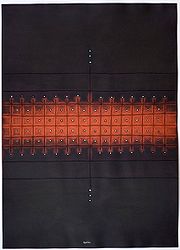
 It is a privilege to introduce the wisdom and art of Sohan Qadri, even in such a small way as this. Such art does not aim to produce theory. It may not even aim for anything. It invites its participant by opening up the vibrant dimension where it arises. It flourishes within the field of the artist’s experience of reality. He breaks through to pure beauty by seeing through illusion and soaring free. Real freedom does not trap itself, it is simultaneously free from itself and so engages with the illusion out of joy and love for others still unfree. Deceiving illusion is transformed into liberating magic. Wisdom releases the artist into bliss. Bliss spontaneously looks with love on others, willing forth their bliss. The artist envisions a space of beauty where her experience can touch the other’s imagination.
It is a privilege to introduce the wisdom and art of Sohan Qadri, even in such a small way as this. Such art does not aim to produce theory. It may not even aim for anything. It invites its participant by opening up the vibrant dimension where it arises. It flourishes within the field of the artist’s experience of reality. He breaks through to pure beauty by seeing through illusion and soaring free. Real freedom does not trap itself, it is simultaneously free from itself and so engages with the illusion out of joy and love for others still unfree. Deceiving illusion is transformed into liberating magic. Wisdom releases the artist into bliss. Bliss spontaneously looks with love on others, willing forth their bliss. The artist envisions a space of beauty where her experience can touch the other’s imagination.
-Dr. Robert Thurman
There are artists. There are tantrik artists. As far as I know, there are no tantrik yogis who are artists as well. Sohan Qadri is an exception. He is an exceptional artist. He is an accomplished master (guru) in the art of yoga. He is an accomplished master in the art of painting. He is a practicing tantrik yogi, who time to time performs the rituals (panch-makra) of eating taboo foods, drinking wine and indulging in ritual fornication. By breaking the law, in this case, he becomes the legislator.
To be an iconoclast, one must know how to build images. To break the law, one must
be a learned lawyer.
Qadri is a learned man. He is a saintly man from whom an aura emanates. Try and expose him as a phoney saint and he emerges as a great artist. Try to put down his art as gimmick and he comes across as a profoundly learned man. Try to debunk his learning and he proves to possess all three—saintliness, aesthetics and wisdom.
There is no doubt in my mind that Sohan Qadri emerges as a rare and original partner. You may look at his paintings as yantras or mandalas and describe them with words that are mantras. You may look at his paintings as symbolic representations of Kundalini, the ‘serpent-power’ or Shakti, said to be coiled in the rear end of the spinal column. You may look at his paintings as mere form and color and enjoy them as pure art. No matter what angle you choose to look from, it reveals one great aspect—that of mysticism. In its aesthetics, the copulation of mater with the spirit is brought to a climax.
Sohan Qadri may be a guru. He may be a tantrik sage. He may be anything extraneous to art. To me he is an artist par excellence. Ajit Mookerjee’s Tantra Art (which I reviewed in Studio International, December 1996) states, “It is not astonishing that many great Indian artists finally become saints.” With Sohan Qadri, it seems to me, the reverse has occurred—but perhaps to revert again.
-F.N. Souza (Painter and Writer),
New York, June 1976
The entire task of Qadri’s art is to achieve this aesthetic concretization of the doctrine of Sunyata. Whether his icons emphasize the void, as in the brooding darkness of Nayana and Ankura as well as the luminous emptiness, rimmed with darkness, of Sunyata IV, or the seed, as the erotically alive colors of Seed, Asha, and Dharma I suggest, they are tense with the dialectic of void and seed—the dialectic of creativity
-Donald Kuspit
Using abstraction to convey transcendence, he is the pre-eminent aesthetic mystic of modernism.
-Donald Kuspit
2007 Sohan Qadri: Presence of Being, Sundaram Tagore Ink, New York, USA. ISBN 8188204358.
2005 Seeker: The Art of Sohan Qadri, Mapin Publishing, New York, USA
1999 Sakshi, The Seer, Art & Deal, New Delhi, India
1995 AntarJoti, Punjabi Sutras, Nav Yug, New Delhi, India
1995 Aforismer, Danish translation of English Sutras,
Omens Forlang, Denmark
1990 Boond Samunder, Punjabi Sutras, Amritsar, New Delhi, India
The Dot & the Dot’s, English Sutras, Writers
Workshop, Calcutta, India
1987 Mitti Mitti, Punjabi sutras, Nava Yug, New Delhi, India
1978 The Dot & the Dot’s Poems & Paintings, Stockholm, Sweden. ISBN 9185778001.
Copenhagen
Copenhagen is the capital and largest city of Denmark, with an urban population of 1,199,224 and a metropolitan population of 1,930,260 . With the completion of the transnational Øresund Bridge in 2000, Copenhagen has become the centre of the increasingly integrating Øresund Region...
for the past 30 years. His paintings result from states of deep meditation, and are informed by the colors of India: luminous, dye-infused works on meticulously serrated paper. Over his long career, Qadri has interacted with a wide array of cultural figures including Surrealist painter René Magritte
René Magritte
René François Ghislain Magritte[p] was a Belgian surrealist artist. He became well known for a number of witty and thought-provoking images...
, Nobel laureate Heinrich Böll
Heinrich Böll
Heinrich Theodor Böll was one of Germany's foremost post-World War II writers. Böll was awarded the Georg Büchner Prize in 1967 and the Nobel Prize for Literature in 1972.- Biography :...
, and architect Le Corbusier
Le Corbusier
Charles-Édouard Jeanneret, better known as Le Corbusier , was a Swiss-born French architect, designer, urbanist, writer and painter, famous for being one of the pioneers of what now is called modern architecture. He was born in Switzerland and became a French citizen in 1930...
. Böll once said, "Sohan Qadri with his painting liberates the word meditation from its fashionable taste and brings it back to its proper origin." He has had more than 70 exhibitions in the United States, Europe, Asia, and Africa.
Early Years in India





Kapurthala District
Kapurthala district is a district of Punjab state in northern Republic of India. The city of Kapurthala is the district headquarters....
of Punjab. He grew up in a wealthy farming family—his mother was Hindu and his father was Sikh. With no electricity, running water, roads or cars, Chachoki was only a few miles from the more cosmopolitan city of Kapurthala, with its many palaces and official buildings in the French Neo-Classical style, which were built by a Francophile maharajah.
As a boy of about seven, two spiritualists living on the family farm entranced him. The first was Bikham Giri, a Bengali Tantric-Vajrayan yogi. The second was Ahmed Ali Shah Qadri, a Sufi, who lived within walking distance of Giri. Both gurus taught him spiritual ideals through meditation, dance and music. Though neither was a teacher in the traditional sense, nor were they interested in proselytizing, their impact was profound. Qadri’s association with them heralded a lifelong commitment to spirituality and art.
Qadri’s artistic talent was first expressed in the village pond. Before bathing, he would play with lumps of mud, shaping them into various toys using sticks and stones. He gouged, scratched and marked the forms— techniques that still prevail in his work—to define features such as eyes and noses. His visual influences came from village life where nature is pervasive. Qadri grew up encircled by the Kangra hills, lush woodlands, gushing streams and a patchwork of cotton and wheat fields.
Qadri continued his schooling in until the eighth grade when he sat for his matriculation exam. His mother wanted him to take charge of the family farm. Initially, he did not display any distress over this, but the anxiety eventually prompted him to run away to the Himalayas. He made his way to Karnaul and into Tibet, staying in monasteries for several months, living among spiritualists and forest dwellers. Meanwhile, his mother dispatched a cousin, a wrestler, to bring him home. He tried to run away twice more but was compelled to return. Eventually, Qadri stood his ground. His refusal to take over the farm dashed his mother’s hopes of extending the family’s upward mobility. Qadri who was the first village child to have gained matriculation, instead completed his three-year undegraduate degree at Ram Garhia College and pursued his art by apprenticing himself to Pyara Singh, a photographer with a studio in Jullandhar, Punjab.
After Pyara Singh immigrated to England in 1952, Sohan left Jullandhar for Bombay. Modernism was an urban phenomenon, and in order to pursue his interest in art he felt he had to leave village life behind. Qadri settled in Parel and worked as a still photographer in an early Bollywood studio in Andheri, Bombay. Unable to find the artistic fulfillment he was seeking, he resigned after completing only two films. While in Bombay he discovered the renowned JJ School of Art and the work of modernist artists Krishna Ara, K.K. Hebbar and Shanti Dave.
Through Ara, Hebbar and Dave, Sohan learned of the existence of fine art colleges where one could receive specialized training, and in 1955, he enrolled in the Simla College of Art, Simla. Satish Gujral, a noted modern painter, was teaching at the college after having spent time with Diego Rivera, Frida Kahlo and David Alfaro Siqueiros in Mexico. The curriculum was modeled after the Royal College of Art in London and also specialized in the Rajput and Mughal styles of painting.
While a student, Qadri visited the art galleries of Delhi. He met the renowned artists Sailoz Mukherjee and J. Swaminathan, who were in the process of starting the group Unknown. He became immersed in the artistic milieu of the pioneering Indian modernists M.F. Husain, Syed Haider Raza, J. Swaminathan, and Ram Kumar. The postwar period was a productive time for emerging artists like Qadri who faced modernism in full bloom. Their predecessors, including the Calcutta Group
Calcutta Group
The Calcutta Group was the first group of modern artists in India, formed in 1943 in Kolkata. Its leading members included the sculptor Pradosh Das Gupta and the painters Paritosh Sen, Gopal Ghose, Nirode Mazumdar and Zainul Abedin...
(1942) and the Progressive Artists Group of Bombay (1947), had already defined a vocabulary of modernism based on certain Indian modes of expression and Western modernist syntax. Qadri and his contemporaries were able to build on this vocabulary and even reject their predecessors’ reliance on figuration, which, these earlier artists believed defined them as authentically Indian.
After finishing his degree, Qadri returned home to Phagwara and joined the faculty of the Phagwara Teachers Training College for three years. In 1961, Dr. Mulk Raj Anand
Mulk Raj Anand
Mulk Raj Anand was an Indian writer in English, notable for his depiction of the lives of the poorer castes in traditional Indian society. One of the pioneers of Indo-Anglian fiction, he, together with R.K...
, the founder and editor of the art journal Marg, and associate of the Bloomsbury Group of London, recognised Qadri’s talent. After viewing his work at a faculty exhibition, he singled Qadri out and promised to visit his village. Anand spontaneously supported young talent throughout India, and he became Qadri’s first major patron. Anand arrived in Phagwara in 1963 with Pierre Jeanneret
Pierre Jeanneret
Pierre Jeanneret was a Swiss architect who collaborated with his more famous brother Charles Edouard Jeanneret for about twenty years....
, an architect and cousin of the architect Le Corbusier, who acquired a painting for his collection.
Anand and Jeanneret invited Qadri to bring his work to the newly built city of Chandigarh, capital of Punjab and Haryana, designed by Le Corbusier. Qadri’s first exhibition was the second exhibition to be held at Gandhi Bhavan, the Punjab University Library art gallery designed by Jeanneret (the first was MF Husain’s). During this time Sohan changed his last name from Singh to Qadri as a sign of devotion to his Sufi teacher.
After gaining critical acclaim, Qadri began to paint seriously, and in the small town of Jullandhar, began to teach himself about the School of Paris. As was often the case with artists living outside European artistic centers, modernism appeared through secondary material – particularly print media. Sohan educated himself by looking at the magazines Studio International, Illustrated Weekly of India, and Modern Review, as well as reading lectures and books. While reading about Francis Newton Souza
Francis Newton Souza
Francis Newton Souza , commonly referred to as F. N. Souza, was an Indian artist. He was a founding member of the Progressive Artists' Group of Bombay, and was the first post-independence Indian artist to achieve high recognition in the West...
, an enfant terrible of Indian art, and his adventures in Paris, Qadri dreamed of visiting modernity’s capital. In the meantime, he built a studio of mud and straw bales in Chachoki and began to teach himself about the Indian and international art scene.
Qadri started creating figurative works, slowly veering toward abstraction, and ultimately abandoning representation in a search for transcendence. “When I start on a canvas,” he says, “first I empty my mind of all images. They dissolve into a primordial space. Only emptiness, I feel, should communicate with the emptiness of the canvas.” Instead of using subject matter drawn from the disaffected, gritty urban world like many of his contemporaries, he searched for subject matter that inspired spiritual feelings and turned to an Eastern mode of expression full of bhava or mood. “I was focusing purely on color and form without distraction from figure,” he says.
Qadri developed the methodology of painting during this period that he still uses today. He divided pure colors into three categories or parts: dark, warm or cool, and light. Dark colors form the earth element or lower level. Warm or cold colors denote energy, each of which possesses a different vibration (vigorous when warm and mild when cold), and form the middle level, and light colors, the upper level. This allowed for a tripartite arrangement that could be organized in descending or ascending order.
In 1962, Qadri had his second exhibition at Sridharani Gallery in New Delhi. After the Sridharani exhibition, and with the help of Randhawa and Dr. Anand in Delhi (then chairman of the Lalit Kala Akademi), several galleries took interest in his work. At the time, Indian artists largely found patrons among the diplomatic or expatriate community, along with a few Indians interested in modern art. Among the collectors of Qadri’s early art were the Belgian Consul and the Canadian and French ambassadors to India.
Journey to Africa


Qadri brought all of his large paintings, which were originally painted in Chachoki for an exhibition at Bombay’s Taj Art Gallery. He hoped to exhibit them in Kenya. When he landed in Mombassa, the port authorities dumped Qadri’s crate of paintings on the pavement because he could not afford a porter. Qadri and his traveling companion sat with the crate for three days and nights until an acquaintance arrived and agreed to drive them the 300 miles to Nairobi.
Once in Nairobi, he contacted Elimo Njau, a Kenyan cultural figure who visited Delhi often. Njau was born in Tanzania and studied fine arts at Makere University College, Uganda. A catalyst of contemporary culture, Njau had established two nonprofit galleries, Paa-yaa-paa in Nairobi and Kibo in Marangu, Tanzania, where both African and international artists exhibited regularly. Njau immediately recognized Qadri’s work, which he had seen in the Kunika Gallery in Delhi. He offered to shuffle another show to squeeze in Qadri’s exhibition. Qadri then went to Prem Bhatia, the Indian ambassador to Kenya, with an introductory letter from Mulk Raj Anand. Bhatia agreed to sponsor the show and use the embassy’s machinery to promote the exhibition. Bhatia bought the first painting for 75 pounds. The show was a sellout and the talk of Nairobi. This exhibition was followed by an equally successful show at the Stanley Gallery in the renovated, American-owned Stanley Hotel.
European Sojourn



Although he had little money, Qadri continued to paint. One day, Kuhn asked Qadri to join him while he interviewed the surrealist painter René Magritte in the artist’s studio. After introductions, Qadri sat quietly while they talked, looking at Magritte’s seminal canvas Ceci n’est pas une pipe sitting on the artist’s easel. After a few hours, Magritte announced that it was his chess time, and that Kuhn should come back the following day to finish the interview. When Qadri told him he’d been a chess champion in Simla, Magritte challenged him to a game, and then quickly beat him.
Before driving with Kuhn from Brussels to Paris to meet Qadri’s first patron, Mulk Raj Anand, and the Indian painter Syed Haider Raza, Qadri sold five paintings to a couple from Montreal who were on their way back to Canada to open a gallery. Once in Paris, he secured an important exhibition in December 1966 at the Gallerie Arnaud alongside major European artists including Pierre Soulages
Pierre Soulages
Pierre Soulages is a French painter, engraver, and sculptor.-Biography:Born in Rodez in 1919, Soulages also is known as "the painter of black" because of his interest in the colour, "...both a colour and a non-colour. When light is reflected on black, it transforms and transmutes it. It opens up...
, George Michaux, Jean Paul Riepal and Louis Fatoux. Seven years later, he would show his works at Arnaud’s sister gallery in Montreal.
When he returned to Zurich, Qadri received an invitation to an international artists’ camp in Kushalin, Poland, where he was given lodging, food and painting materials for two months. The Souks Museum of Modern Art in Kushalin acquired one of the paintings he produced during this period. Next to his studio were two Danish artists, painter Bent Kock, and printmaker Helle Thorborg, who were impressed with Qadri’s work. In 1969, Thorborg arranged for him to visit Copenhagen, through the Danish cultural ministry.
Before going to Copenhagen, Qadri showed his work in Vienna at the gallery Uni Generation and at the Government Printing Press called d’Orchai. He also showed in Munich at Stenzel Gallerie and stayed for a period in 1968 in Paris where he rented American artist Mimi Vaz’s studio in Villa d’Essai. There he mixed with Pierre Soulages and James Michaux, whom he had met at the Arnaud Gallerie, along with the Indian artists Syed Haider Raza, Anjolie Ela Menon, N. Vishwanadhan, and Nikita Narayan. He also met well-known printmaker Krishna Reddy
Krishna Reddy
Krishna Reddy is an Indian printmaker and sculptor.-Education:He studied at Vishva-Bharait University, Shantiniketan, West Bengal, from 1941 to 1946, with a degree in Fine Art. From 1947-1950, Reddy was head of the art section at Kalaksherra, Madras...
who was working with his wife, Judy Reddy and the British painter Stanley William Hayter
Stanley William Hayter
Stanley William Hayter , CBE was a British painter and printmaker associated in the 1930s with Surrealism and from 1940 onward with Abstract Expressionism. Regarded as one of the most significant printmakers of the 20th century, in 1927 Hayter founded the legendary Atelier 17 studio in Paris...
.
During this time, Qadri stopped painting with impasto oil on canvas and experimented with paper. Though the oils sold well, paper, he felt, was softer, more feminine, and more suited to works that evolved out of a meditative state. “Deep states of being are not brought out by effort,” he says. “When I work with ink and dyes, I don’t have to fight with the canvas. There are no brush strokes, no painter. The aura of the form is the painting.”
While in Paris, the Danish Ministry of Culture offered Qadri a show, including traveling expenses and a stipend. The ministry’s gallery director bought a painting, as did New Yorker Sam Kanner of Court Gallerie. Christian Oberg, from the graphic department of Denmark’s Louisiana Museum, bought several paintings and arranged five exhibitions for Qadri in Denmark.
Life in Copenhagen


The villa, located in the Hellerup area of Copenhagen next to the Indian embassy, was filled with free-flying birds, fish, dogs and turtles. In one of the many dust-covered upper rooms was a giant toy train and in another, Schimitto’s mother’s clothes, laid out just as they were the day she died. Schimitto asked only where Qadri was from, what his profession was and whether he could paint in the villa’s odd surroundings. When Qadri said he could, Schimitto invited him to stay, and Qadri did, except for brief periods, for eighteen years.
In 1973, a few years after settling in Copenhagen, Qadri met another of his most important patrons, Nobel laureate Heinrich Böll. He was introduced to the celebrated writer during a show at the Bodo Galuab Gallery in Cologne, Germany. Böll bought several paintings and wrote about Qadri’s work. Also during this period Qadri, along with American psychedelic painter Linda Wood and Pere Bacho, took over an old gun factory and help found the free city called Christianna which still exists in Copenhagen. In the spirit of the times, everything belonged to everyone in Christianna. There was little privacy and hashish was freely available. Although he enjoyed the openness, it was an impossible environment in which to work. Six months later, Qadri returned to Hellerup, where he stayed until Dr. Shimitto’s death in 1986. He eventually moved into government-sponsored artists’ housing where he lives today.
Though he continued to produce works on canvas, by the mid-1970s, paper was Qadri’s preferred medium. “I was perpetually seeking a medium where effort is superfluous. Deep states of being are not brought out by effort,” he says. His work, he says, is not philosophical—it is not supposed to excite the thinking process. On the contrary, his aim is to arrest the thought process, as in meditation, which Qadri practices daily and teaches.
Qadri’s works are largely monochromatic surfaces which he penetrates with punctures and serrations. The Buddhist scholar Robert Thurman
Robert Thurman
Robert Alexander Farrar Thurman is an influential and prolific American Buddhist writer and academic who has authored, edited or translated several books on Tibetan Buddhism. He is the Je Tsongkhapa Professor of Indo-Tibetan Buddhist Studies at Columbia University, holding the first endowed chair...
has described his dots and striations as “lustrous bubbles of energy.” Qadri transforms paper with these markings making it into a three-dimensional surface. Despite the fact that he lives in Northern Europe, a sense of Indian ethos pervades his art. His colors are luminous—Sindoori reds, peacock blues, intense oranges, even heavy blacks and grays—and distinctly Indian. Colors fade and seep through the paper. The vibrations created by the colors are endless and break the boundary between the inner space of the image and the external space of the viewer.
Throughout the 1980s and 1990s, Qadri’s artistic productivity grew and he was invited to have exhibitions in Los Angeles, Copenhagen, Nairobi, New Delhi, Bombay, Singapore and New York. Although he never married, he helped raise his three children with two partners, one a Keralite Christian and the other a Finn. It was also during this time that he began to plan a spiritual earth art project, a gyan stambha or knowledge stupa, located on an ancient trading route in the Punjab in India. The structure, which will eventually occupy several acres of land, will be devoted to knowledge and peace. Construction of the stupa is in progress. Along with creating his art, Qadri has continued to teach meditation throughout Scandinavia to advanced students.
Qadri’s has successfully straddled disparate cultures throughout his career. “I did not want to confine myself to one place, nation or community,” he says. “My approach to life has been universal, and so is my art.”
Quotations


-Dr. Robert Thurman
There are artists. There are tantrik artists. As far as I know, there are no tantrik yogis who are artists as well. Sohan Qadri is an exception. He is an exceptional artist. He is an accomplished master (guru) in the art of yoga. He is an accomplished master in the art of painting. He is a practicing tantrik yogi, who time to time performs the rituals (panch-makra) of eating taboo foods, drinking wine and indulging in ritual fornication. By breaking the law, in this case, he becomes the legislator.
To be an iconoclast, one must know how to build images. To break the law, one must
be a learned lawyer.
Qadri is a learned man. He is a saintly man from whom an aura emanates. Try and expose him as a phoney saint and he emerges as a great artist. Try to put down his art as gimmick and he comes across as a profoundly learned man. Try to debunk his learning and he proves to possess all three—saintliness, aesthetics and wisdom.
There is no doubt in my mind that Sohan Qadri emerges as a rare and original partner. You may look at his paintings as yantras or mandalas and describe them with words that are mantras. You may look at his paintings as symbolic representations of Kundalini, the ‘serpent-power’ or Shakti, said to be coiled in the rear end of the spinal column. You may look at his paintings as mere form and color and enjoy them as pure art. No matter what angle you choose to look from, it reveals one great aspect—that of mysticism. In its aesthetics, the copulation of mater with the spirit is brought to a climax.
Sohan Qadri may be a guru. He may be a tantrik sage. He may be anything extraneous to art. To me he is an artist par excellence. Ajit Mookerjee’s Tantra Art (which I reviewed in Studio International, December 1996) states, “It is not astonishing that many great Indian artists finally become saints.” With Sohan Qadri, it seems to me, the reverse has occurred—but perhaps to revert again.
-F.N. Souza (Painter and Writer),
New York, June 1976
The entire task of Qadri’s art is to achieve this aesthetic concretization of the doctrine of Sunyata. Whether his icons emphasize the void, as in the brooding darkness of Nayana and Ankura as well as the luminous emptiness, rimmed with darkness, of Sunyata IV, or the seed, as the erotically alive colors of Seed, Asha, and Dharma I suggest, they are tense with the dialectic of void and seed—the dialectic of creativity
-Donald Kuspit
Using abstraction to convey transcendence, he is the pre-eminent aesthetic mystic of modernism.
-Donald Kuspit
Selected bibliography
2009 Wonderstand: The poems “Aphorisms” and “The Dot and the dots”, Bindu Publishers, Stockholm, Sweden. ISBN 978-91-977894-0-0.2007 Sohan Qadri: Presence of Being, Sundaram Tagore Ink, New York, USA. ISBN 8188204358.
2005 Seeker: The Art of Sohan Qadri, Mapin Publishing, New York, USA
1999 Sakshi, The Seer, Art & Deal, New Delhi, India
1995 AntarJoti, Punjabi Sutras, Nav Yug, New Delhi, India
1995 Aforismer, Danish translation of English Sutras,
Omens Forlang, Denmark
1990 Boond Samunder, Punjabi Sutras, Amritsar, New Delhi, India
The Dot & the Dot’s, English Sutras, Writers
Workshop, Calcutta, India
1987 Mitti Mitti, Punjabi sutras, Nava Yug, New Delhi, India
1978 The Dot & the Dot’s Poems & Paintings, Stockholm, Sweden. ISBN 9185778001.
External links
- Sohan Qadri website
- Sundaram Tagore Gallery
- sohanqadri.com
- Interview on Beliefnet.com BeliefnetBeliefnetBeliefnet is a large multi-faith e-community that aims to provide a free forum for religious information and inspiration, spiritual tools, and discussions and dialogue groups. Beliefnet provides information about various religious and spiritual beliefs, ranging from Christian denominations to...
- Interview on Bindu Magazine
- Yogini: Article by Sohan Qadri on Bindu Magazine

